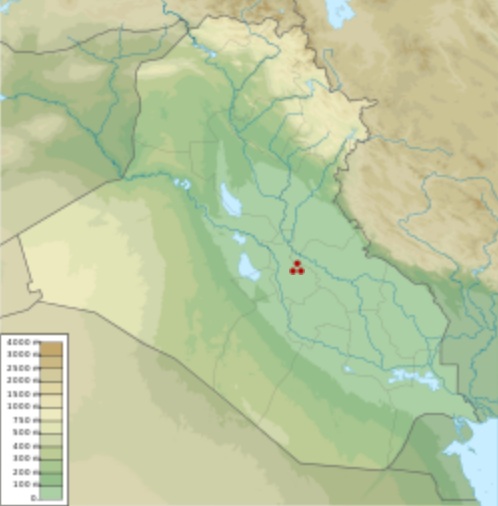TELL
UQAIR

Tell
Uqair / Urum within Iraq
Alternative
name :
Tell Uquair, Tell Aqair
Location
: Babil Governorate, Iraq
Region
:
Mesopotamia
Coordinates
:
32°46'54 N 44°39'53 E
Type
:
tell
Site
notes :
Excavation
dates :
1941–1942
Archaeologists
:
S. Lloyd, Taha Baqir, F. Safar
Tell
Uqair (Tell Uquair, Tell Aqair) is a tell or settlement mound northeast
of Babylon and about 50 miles (80 km) south of Baghdad in modern
Babil Governorate, Iraq.
History
of archaeological research :
The site of Tell Uqair was excavated during World War II, in 1941
and 1942, by an Iraqi Directorate General of Antiquities team led
by Seton Lloyd, with Taha Baqir and Fuad Safar. The buildings and
artifacts discovered were primarily from the Ubaid period, the Uruk
period, and the Jemdet Nasr period and included four proto-cuneiform
tablets. A sounding was done by a team from the Heidelberg University
in 1978.
Tell
Uqair and its environment :
Tell Uqair is a small mound just north of Tell Ibrahim, the large
mound marking the site of ancient Kutha. The topography consists
of two sub-mounds separated by what is apparently the bed of an
ancient canal. At maximum the hills are 6 metres (20 ft) above the
terrain line.
Occupation
history :
The site of Tell Uqair first had significant occupation during the
Ubaid period, and grew to its greatest extent during the Jemdet
Nasr and Uruk periods. Some Early Dynastic graves and a scattering
of Akkadian and Babylonian artifacts indicate the location continued
in limited use up through the time of Nebuchadnezzar. Because of
clay tablets found at the site, it is believed to be the ancient
town of Urum. The toponym for Urum is written in cuneiform as ÚR×Ú.KI,
URUM4 = ÚR×HA, besides ÚR×A.HA.KI, from
earlier (pre-Ur III) ÚR.A.HA.
The
most prominent discovery at Tell Uquair was the "Painted Temple",
a large complex similar in design to the "White Temple"
found at Uruk. Some of the original frescos were still visible at
the time of the excavation and were copied. Several frescos were
recovered intact and sent to the Baghdad Museum. The temple is believed
to date to the Uruk or early Jemdet Nasr period. A small adjacent
Jemdet Nasr temple was of somewhat later construction and contained
large amounts of pottery from that period.
Source
:
https://en.wikipedia.org/
wiki/Tell_Uqair

